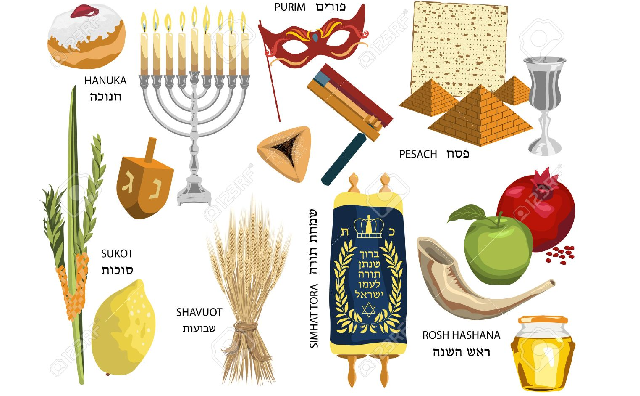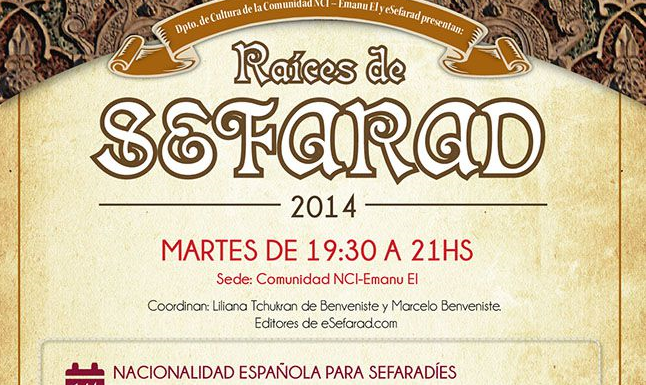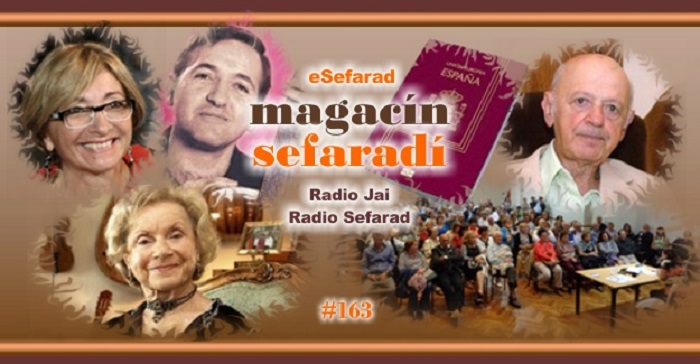EMPEZAR QUIERO CONTAR, CON JUDITH COHEN – En la última entrega hablábamos de las canciones del ciclo de la vida. Hoy lo haremos de las del ciclo del año judío y de shabat. En vez de romances, cantares o canticas, muchas son coplas, con varias estructuras, o piyyutim – un piyyut es un tipo de poema religioso. Empezamos con shabat, con una versión de “Ein kelohenu”, o “Non komo muestro Dio”, de la ex -Yugoslavia. Canta el jazán Asher Alcalay, de Serbia, que también canta con el nombre de Stefan Sablic con el grupo Shira u’T’fila.
Después de shabat, empieza la nueva semana. Aquí el rabino-jazán Isaac Algazi canta la canción de havdalá “Al Dio alto”. Ya os he hablado de este gran rabino y jazán, que nació en Turquía en 1889 y falleció en Uruguay en 1950. La grabación es de los años 30.
Vamos a empezar el año donde empieza, en Rosh Hashaná, el año nuevo, a principios del otoño. Aquí el jazán Jacob Sadicario de Salonica canta la traducción al judeoespañol del piyyut “Et sha’arei ratsón”, que narra el sacrificio de Isaac. Explica Shoshana Weich-Shahak, que grabó esta versión, que al oír estas palabras cantadas las mujeres presentes en la sinagoga solían llorar.
Para Simjat Torá, la alegría de la Torá, una canción clásica es “Hi Torá lanu nitana”, “Ésta es la Torá que nos fue dada”. Se canta en una mezcla de hebreo y judeoespañol, típica de los cantes paralitúrgicos. La melodía es de un romance que narra las aventuras de una mujer pomposa y un hombre gastador. Canta Ester Roffé de Alcazarquivir, Marruecos, que vive en Caracas.
Janucá para los sefardíes no se celebra con el sevivón, el dreydl de los ashkenazíes. Tampoco se comen látkes sino buñuelos, pero la idea es la misma: celebrar el milagro del aceite comiendo delicias preparadas con aceite. En esta canción de Janucá también gozan de la “Gayina de la cuzina” y del vino. La interpreta Berta / Bienvenida Aguado, de Cannakale, Turquia, residente en Bat Yam, Israel.
Preparé este programa justo después de Tu BiShevat, la celebración de los árboles (aunque donde estaba, en Canadá, aquel día la temperatura estaba a 30 bajo cero y no pensábamos ver las hojas salir en el futuro inmediato). “Las coplas de las flores” que se cantan en esa festividad son relativamente poco conocidas. La forma es antigua – tiene sus raíces en los debates poéticos de la Edad Media, como el Parlamento de los Pájaros. Aquí las flores debaten entre ellas: cuál es la más hermosa, la que más merece alabar al Creador. Se oye una alternancia entre un patrón métrico de dos y otro de tres, que por un lado es muy frecuente en la música del norte de Marruecos, y que por otro lado también se llama “hemiola”, muy típica de la música del Renacimiento. Canta Solly Levy con Gerineldo.
Purím, en febrero o marzo, abunda en canciones, disfraces, máscaras, comidas y bebidas… Se cantan las largas Coplas de Purím que narran la historia de Ester. Aquí hay dos extractos: de Salonica, cantado por David Saltiel, seguido por Solly Levy y el grupo Gerineldo, de Marruecos. El primer verso de esta versión marroquí, “Empezar quiero contar”, ha dado su título a este programa.
Purím es fiesta de disfraces y máscaras ¿y dónde saben más de máscaras y disfraces? En Venecia. La canción que sigue es de la región de Venecia y Livorno, donde se refugiaron muchos judíos sefardíes de España y de Portugal después de la Expulsión. Es de la colección Leo Levi, de los años 50-60, de un CD preparado por mi amigo y colega, el etnomusicólogo Francesco Spagnolo. Las letras hablan de beber sin ser considerados “shikorim”, borrachos; y de preparar los bonnoncini – los platos dulces – zittele, caboletti, moscardini… La melodía se parece a una de Purim de Marruecos .
Los ashkenazíes hacían Purimshpil, teatro de Purím en ídish, mientras que los sefardíes representaban en esas fechas operetas. Bouena Sarfatty Garfinkle, de Salónica, era una partisana durante el Holocausto, que rescató a muchos niños judíos. A finales de la Segunda Guerra Mundial se casó con un canadiense ashkenazí, y vivió la segunda parte de su vida con él en Montreal. Allí, en los años 80, tuve la gran suerte de poder grabarle varias veces. Éste es un breve extracto del diálogo entre Hamán y Ester de una opereta de Purim de Salónica, cantada por Bouena Sarfaty Garfinkle.
Después de Purím parece que a las mujeres casi no les queda tiempo para preparar la casa para Pesaj. Hay que sacar la vajilla especial y guardar el jametz, como cantábamos con Gerineldo.
“Ejad mi yode’a” es una de las canciones acumulativas cantadas al final de la cena de Pesaj, de la Pascua judía. Forma parte de una tradición antiquísima, que se encuentra en varias tradiciones, y que existe también en España y Portugal fuera del ámbito judío. En España, se canta a menudo como parte del repertorio navideño, pero en Portugal, en ciertas regiones, se canta o se recita, de manera muy solemne, en la ocasión de la muerte. Esta tradición en Portugal existe especialmente en las zonas donde viven más criptojudíos, aunque no son solamente ellos quienes lo cantan. La otra canción acumulativa cantada en esta ocasión es “Jad gadya”, “Un cabrito”, que también existe en versiones no judías. Esta versión en judeoespañol de “Ejad mi yode’a” está cantada por Dora, o Loretta, Gerassy en Israel, originaria de Bulgaria.
En mayo, en Marruecos, se celebran las hilulót, un tipo de romerías, a las tumbas de los rabinos venerados. Aquí Kelly Sultan Amar y Solly Levy de Gerineldo cantan un cantar de hilulá; se oye el violín de Charly Edry.
Muchas canciones de Simjat Torá se cantan también para Shavu’ot, la celebración de la entrega de la Torá a Moisés. Más tarde en el verano, en Tisha be’Av, el día de luto, se cantan las endechas o las oínas. Alicia Benassayag canta esta endecha marroquí, grabada por Shoshana Weich-Shahak. Está considerado que da mala suerte cantar una endecha fuera de la ocasión, y Alicia me explicó, cuando la conocí unos años después, que lo hizo porque no quería que estas endechas se perdiesen. La melodía es la de la qiná, de lamento, con la cual se canta la versión de Tisha be’Av de Don Gato, que hemos escuchado aquí mismo la otra vez. Escucharemos la primera estrofa solamente de esta letra muy antigua.
Acabamos el programa de hoy con una oración de las mujeres sefardíes de Bosnia, arreglada y cantada por Flory Jagoda: pide la paz y el amor para todos. Y con esto, se acaba ya esta cuarta entrega. En la próxima, escucharemos algunas canciones de amor – y de dolor. Hasta entonces, saludos desde Canadá, a todos los oyentes de Radio Sefarad de vuestra amiga Judith Cohen.
[TEXT IN ENGLISH:
- EMPEZAR QUIERO CONTAR with Judith Cohen. Songs of the Jewish calendar cycle.
Hi, I’m Judith Cohen, speaking to you from Canada. The last time we were here at Radio Sefarad together, we talked about songs of the life cycle, the ciclo de la vida. Today we’ll explore songs of the Jewish calendar cycle. The majority of these are in the form known as coplas, and many are piyyutim – a piyyut is a type of metrical religious sung poem, usually in Hebrew. Let’s begin shabat and a version of the well-known“Ein kelohenu”, or “there is none like our God”, from ex-Yugoslavia. The singer is Hazan Asher Alcalay, of Serbia, also known as Stefan Sablic, the leader of the ensemble Shira u’T’fila.
After shabat, the new week begins. Here rabbi-hazan Isaac Algazi sings the havdalá song“Al Dio alto”. We’ve already listened to this legendary rabbi and hazan, born in Turkey, where his recordings, including this one from the 1930s, were made, and spent the last years of his life in uruguay, where he passed away in 1950.
Let’s begin the songs of the yearly cycle where the year begins, early in the autumn with the Jewish New Year, Rosh Hashaná. Here the hazan Jacob Sadicario of Salonica sings the Judeo-Spanish translation of the Hebrew piyyut “Et sha’arei ratsón”, which tells the story of the sacrifice of Isaac. Ethnomusicologist Shoshana Weich-Shahak, who recorded this version,remarks that when the women in the synagogue heard these words sung, they wept.
For Simkhat Torá, lthe celebration of the Torah, a classic song among Moroccan Sephardim is Moroccan “Hi Torá lanu nitana”, “this is the Torah given to us.” It’s sung in a mixture of Hebrew and Judeo-Spanish, typical of para-liturgical songs. The melody is that of a romance, a narrative ballad, which relates the adventures of a show-off woman and her spendthrift husband, sung here by Ester Roffé of Alcazarquivir, Morocco, residing in Caracas.
Hanuka among Sephardim does not include the sevivón, the Ashkenazi dreydl . And the Sephardic delicacy recalling the miraculous oil is not the potato látke, but rather the buñuelo, a type of doughnut. In this Hanucá song, “Daki’l tas”, families also enjoy chicken and wine. The singer is Berta / Bienvenida Aguado, of Çannakale, Turquia, who spent most of her adult life in Bat Yam, Israel.
I put this week’s programme together just after Tu BiShevat, the celebration of the trees (though this was written from Canada, on a day where the temperature was 30 below zero and we weren’t expecting to celebrate the appearance of buds or leaves any time soon). “Las coplas de las flores” , “The debate of the flowers”, is a relatively little-known song associated with this day. Its form is an old one: it goes back to the poetic debates of the Medieval period, which included the “Parliament of the Birds.” In this text, the flowers argue with each other about which is the most beautiful, and the most useful – the one most suited to praise the Creator. In this Moroccan version, we hear a metrical pattern which alternates between two and three, a typical feature of Moroccan music, and also typical of Renaissance European music, where it was known as a hemiola. Let’s hear Solly Levy sing it, with Gerineldo – we learned it from him.
Purím, in late February or March, is abounds in songs, masks, costumes, food and drink. Songs include the long Coplas de Purím , which tell the story of Esther. Here are two extracts from it: from Salonica, sung by David Saltiel, and from Morocco, sung by Solly Lévy. The first line of Solly’s Moroccan version, “Empezar quiero contar” – “I’d like to begin to tell the story…” – gave me the title for this series on Radio Sefarad.
Purím features masks and costumes, and masks bring Venice to mind. The next song is from Venice and Leghorn (Livorno), where many Jews took refuge from Spain and Portugal after the Expulsion. It’s from the Leo Levi collection, of the 1950s and 1960s, on a CD selected and annotated by my friend and colleague Francesco Spagnolo. The words speak of drinking without being considered “shikorim”, drunkards; and of preparing bonnoncini – plates full of sweet delicacies: zittele, caboletti, moscardini… The melody is similar to a Purim song from Morocco.
Ashkenazi Jews revelled in the Yiddish Purimshpil, Purím play, while Sephardim created Purim operettas Bouena Sarfatty Garfinkle, of Salónica, was a partisan during the Holocaust, and rescued many Jewish children. At the end of World War II, she married an Ashkenazi Canadian, and spent the rest of her life in Montreal, Canada, where I had the good fortune to record her in the 1980s. Here is a brief extract from her rendition of a dialogue between Esther and Haman, in a Purim operetta from Salonica.
After Purím , it seems that women barely had time to prepare the house for Pesakh, Passover. As we sing in Gerineldo, it’s time to take out the special dishes for Passover and clear the house of hametz.
“Ekhad mi yode’a” , “Who knows One?”, is a cumulative song typically sung at the end of the seder. The text belongs to a very old tradition, found in many cultures, including non-Jewish Spain and Portugal. In Spain, it’s often sung during the Christmas season, but in Portugal, in certain regions, it’s entoned, solemnly, at a deathbed. This tradition is especially prevalent in areas of rural Portugal where many Crypto-Jews lived (and sometimes still live), but others sing it as well. Another cumulative song is the well-known “Had gadya”, “One Kid”, which also exists in non-Jewish versions. This one in Judeo-Spanish is sung by Dora, or Loretta, Gerassy, of Bulgaria, at her home in Israel.
Moroccan Sephardim celebrate the hilulá, a type of pilhrimage, to the tombs of venerated rabbis, and in one case, to the tomb of a woman, the young 19th century martyr Sol Hachuel. Here Kelly Sultan Amar and Solly Lévy, with Gerineldo, sing a hilulá song, accompanied by violinist and violin-builder Charly Edry.
Some Simkhat Torah songs are also sung at Shavu’ot, the celebration of Moses receiving the Torah. Later in the summer comes Tisha be’Av, the Ninth of Av and Day of Mourning, when laments – endechas or oínas were sung. Alicia Benassayag sings this one, of which we’ll just listen to the first stanza, from Morocco, recorded by Susana Weich-Shahak. It is considered bad luck to sing an endecha at another occasion, and Alicia told me, when I met her years later, that she had agreed to sing and record it so that it didn’t disappear. The melody is one used for a Hebrew language lament, a qiná, which is also used for the Tisha be’Av version of Don Gato, Sir Cat, which we heard here in the last programme.
We’ll end this week’s programme with a Sephardic mother’s prayer, arranged and sung by Flory Jagoda: the lyrics pray for peace and love for all. pide la paz y el amor para todos. And here we end this fourth programme of our series. In the next one, we’ll hear some songs of love – and its too frequent companion, sorrow. Till then, greetings from Canada to everyone at Radio Sefarad and all you listeners, from your friend Judith Cohen.]




